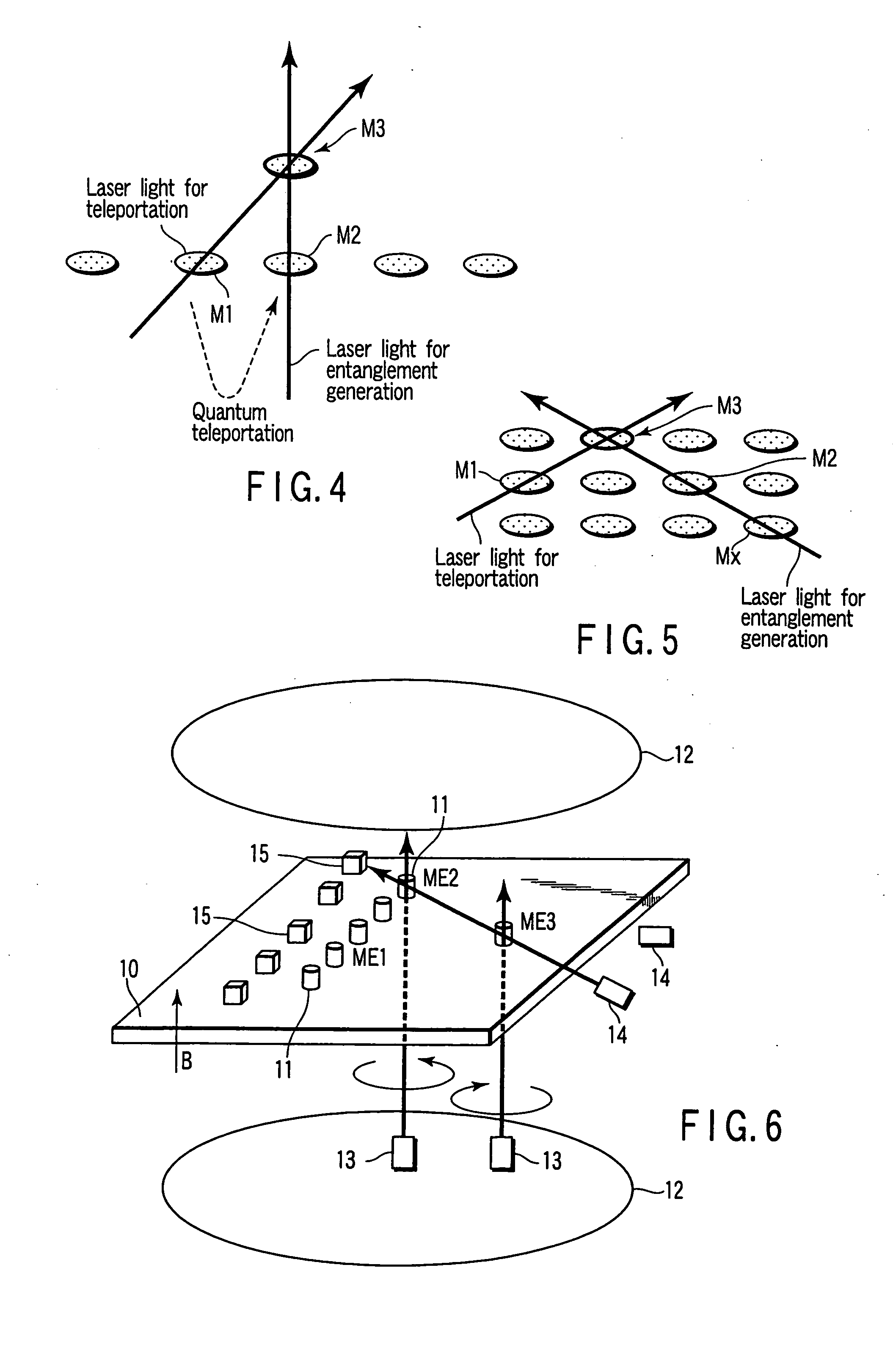Quantum memory and information processing method using the same
a technology of information processing and quantum memories, applied in nanoinformatics, instruments, computing models, etc., can solve the problems of not being able not being able to meet the requirements of quantum memories, and not being able to use quantum memories to carry out teleportation
- Summary
- Abstract
- Description
- Claims
- Application Information
AI Technical Summary
Benefits of technology
Problems solved by technology
Method used
Image
Examples
example 1
[0047] The quantum memory of the present example will be described with reference to FIG. 6.
[0048] Six memory cells 11 were provided in each of which cesium atomic gas was filled into a cylindrical glass cell having a radius of 1 cm and a height of 3 cm. The memory cells 11 were arranged on the same plane on a stage 10. One of the six memory cells 11 was used as the transfer memory cell transferring the quantum state (ME3), whereas the five other memory cells are used as storage memory cells storing the quantum state. In this case, the five storage memory cells were arranged on the same straight line. The transfer memory cell ME3 is arranged off the straight line on which the storage memory cells were arranged.
[0049] Coils 12, 12 were provided above and below the stage 10, respectively, so as to apply a vertically upward magnetic field of 0.9 G to all the memory cells 11.
[0050] First lasers 13 are provided below the stage 10 to irradiate all the memory cells 11 with first laser l...
example 2
[0055] The quantum memory of the present example will be described below with reference to FIG. 7.
[0056] A cylindrical glass cell 20 was provided which had a radius of 20 cm and a height of 3 cm and which was filled with cesium atomic gas. The glass cell 20 was installed in place of the stage and memory cells in Example 1.
[0057] The glass cell was irradiated, in three positions of it from lower side, with light corresponding to the first laser light L1 in Example 1 to select these parts as memory cells ME4, ME5, and ME6. The memory cells ME4 and ME5 were used to store quantum information, whereas the memory cell ME6 was used to transfer quantum information. The memory cells were subjected to light irradiation and homodyne detection similar to those carried out in Embodiment 1. Then, the quantum state of the memory cell ME4 could be transferred to the memory cell ME5.
[0058] By selectively irradiating a spatially continuously and uniformly distributed substance with light without u...
example 3
[0059] Six cylindrical Y2SiO5 crystals were provided each of which had a radius of 1 mm and a height of 2 mm and to each of which 0.05% of Pr3+ ions were added (0.05% of the Y3+ ions were replaced with Pr3+ ions). These crystals were mounted on the stage and used as memory cells in place of the glass cell containing cesium atomic gas in Example 1. All the memory cells consisting of the Y2SiO5 crystals, including the stage, were placed in a cryostat with an optical window and cooled at 3.8 K.
[0060] Third laser light L3 was used instead of the first laser light L1 in Example 1. The laser light L3 was circularly polarized light of wavelength 606 nm resonant with the transition from 3H4 to 1D2of the Pr3+ ion.
[0061] Fourth laser light L4 was used instead of the second laser light L2 in Example 1. The laser light L4 was linearly polarized light that was offset from the transition from 3H4 to 1D2 of the Pr3+ ion toward the short wavelength by 20 GHz.
[0062] Operations similar to those of...
PUM
 Login to View More
Login to View More Abstract
Description
Claims
Application Information
 Login to View More
Login to View More - R&D
- Intellectual Property
- Life Sciences
- Materials
- Tech Scout
- Unparalleled Data Quality
- Higher Quality Content
- 60% Fewer Hallucinations
Browse by: Latest US Patents, China's latest patents, Technical Efficacy Thesaurus, Application Domain, Technology Topic, Popular Technical Reports.
© 2025 PatSnap. All rights reserved.Legal|Privacy policy|Modern Slavery Act Transparency Statement|Sitemap|About US| Contact US: help@patsnap.com



